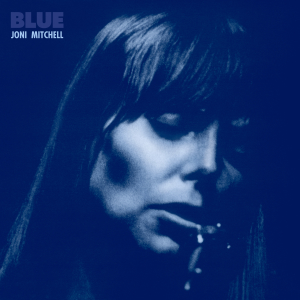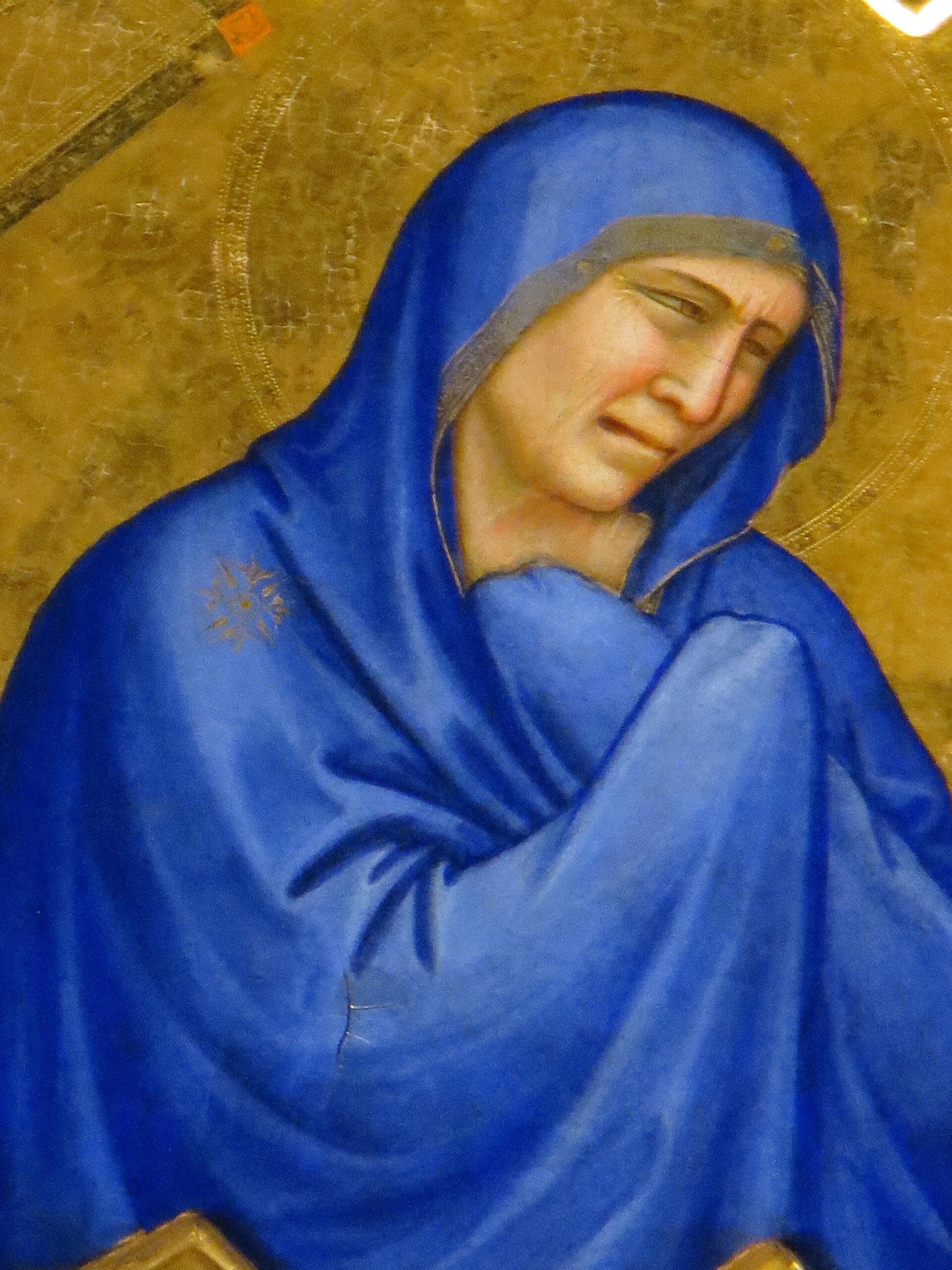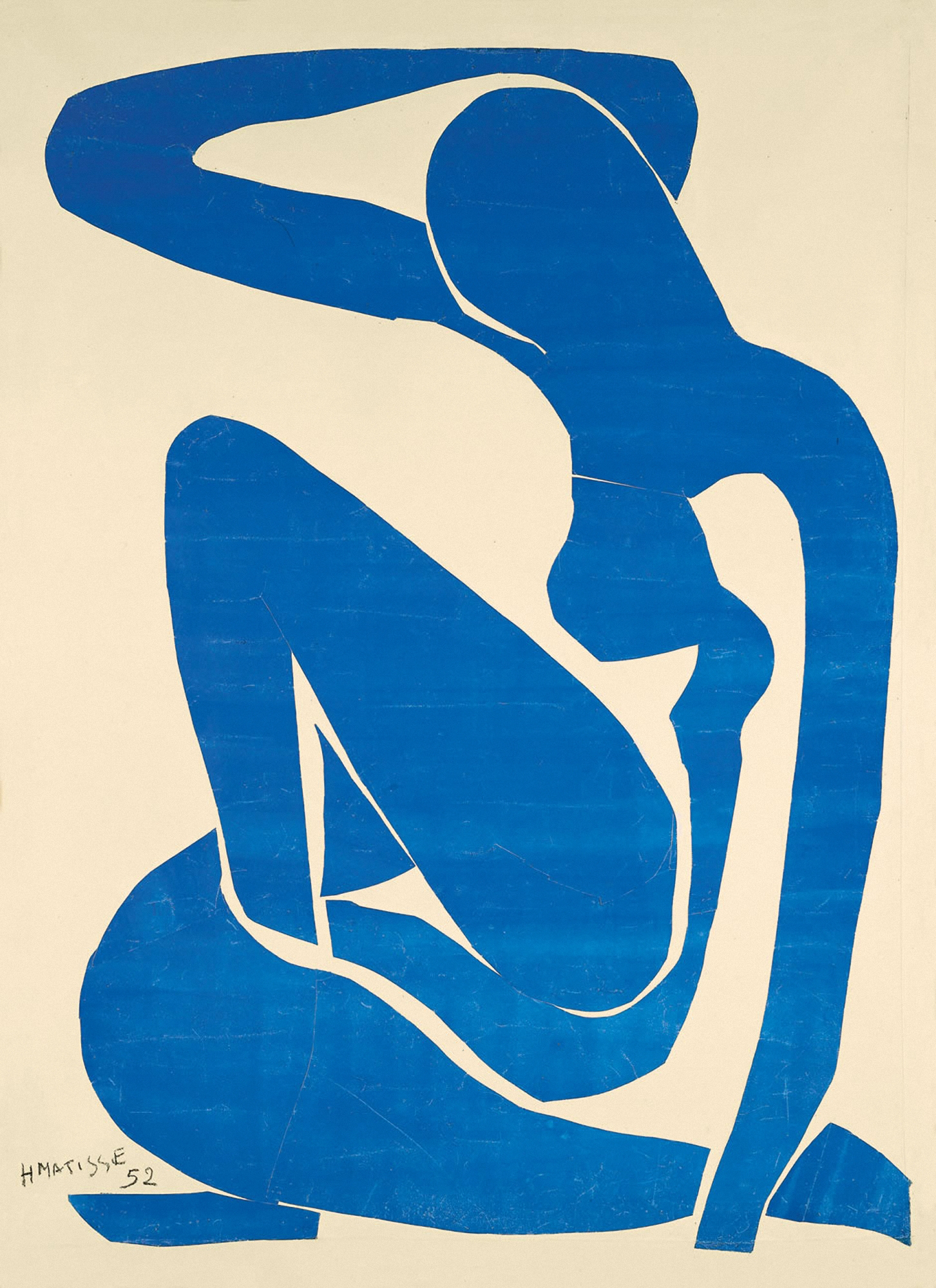“Blue” bears many meanings. It manifests as an aloof sense of dull sorrow one moment. At other times, as in the painterly arena, blue may connote distinct veneration or convey an electrifying, hopeful chromatic hit. In its most subdued form, it is simply a placid purveyor of expansive tranquillity. There is an element of psychology behind our emotional reactions to blue, but there is also a felt sense of the colour which can only stem from our own lived experiences. This is what artists tap into when they set off into “blue” territory – and, indeed, it’s what we connect to when we experience the fruits of their explorations of this multi-faceted, emotionally conductive colour.
Joni Mitchell’s Blue
The bitter-sweet melancholia of blue flows through much of the music that moves us. This year marks the fiftieth anniversary of what is largely considered one of the greatest albums of all time: Joni Mitchell’s Blue. The meandering melodies, punctuated with swopping and soaring vocals, forms an emotionally fraught chronicle of the artist’s romantic relationships. It was written entirely by Joni and recorded in 1971 along the azure Californian coast following her sojourn through Europe. Her time abroad was spent traversing the Mediterranean Isles and great historic cities of the Continent in a bid to reclaim herself from past lovers. She undertook the hard work of extricating herself from an intensely intimate relationship with Graham Nash and the life they shared in Laurel Canyon. It was a time of personal rediscovery – of new beginnings, but also the endings that inevitably accompany them. Blue, in this sense, echoes an air of melancholia welling up from the shifting tides of romantic life and the trials of standing on one’s own two feet as the sole architect of one’s existence. In Joni’s case, there is power in the self-possession that comes from isolation, alienation, and loneliness. Indeed, that’s how much of great art is made; and Blue is no exception.
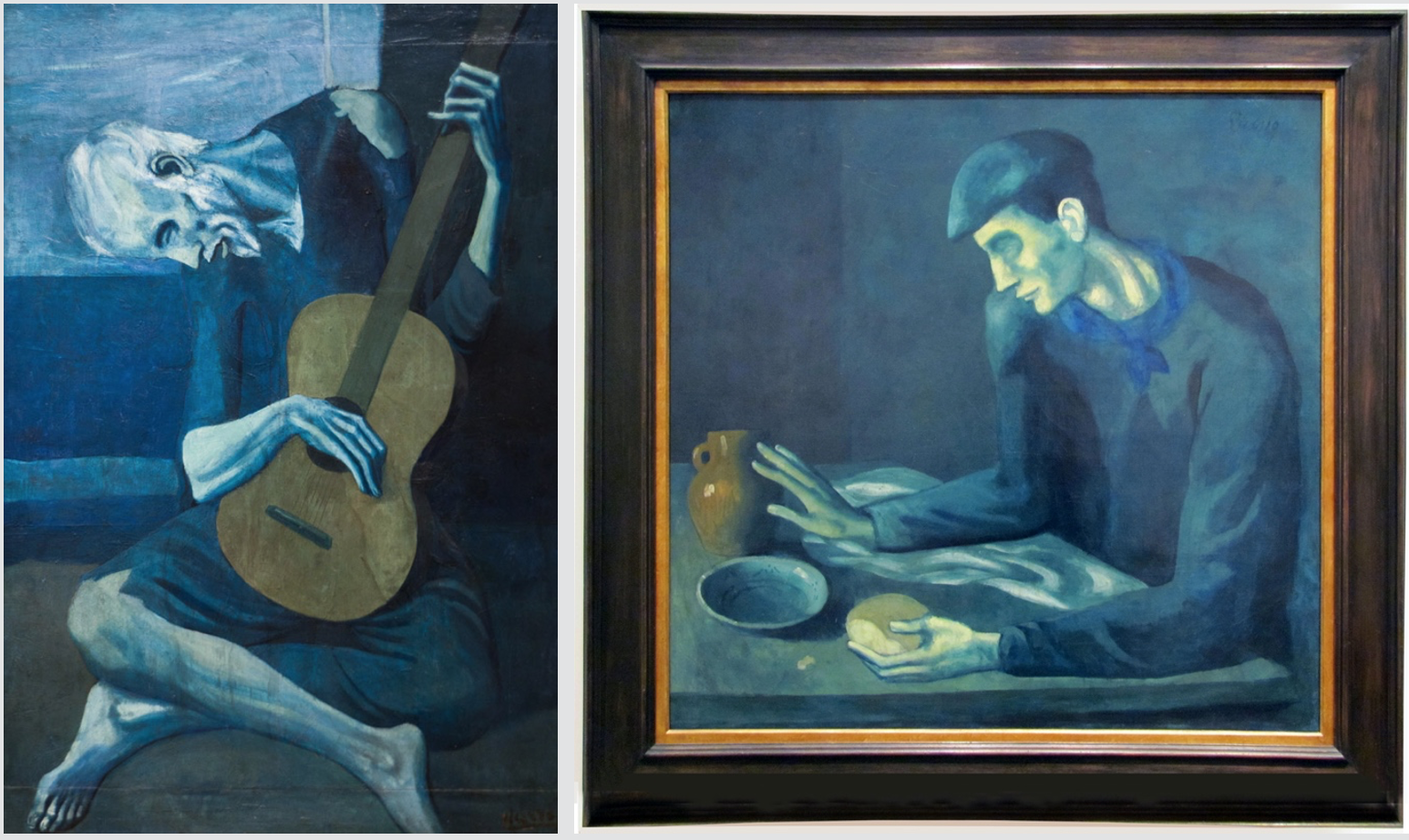
LEFT: PABLO PICASSO’S THE OLD GUITARIST (1904); Right: Pablo Picasso’s Blind Man’s Meal (1903)
Pablo Picasso’s Blue Period
Many great artists are able to harness the quiet power that hums through “the blues”. Pablo Picasso famously emerged from his “Blue Period” to revolutionise the visual art world. Though, the works he created during his turbulent time exploring the forlorn, visceral emotionality of the colour were some of his most sentimentally poignant. Picasso’s blue figures appear broken and almost indifferent towards their being so. The Old Guitarist(1904) crumples under the weight of sorrow. The sitter in Picasso’s Blind Man’s Meal (1903) carries himself in a similar way, head bowed in dispassionate resignation. The entirety of each scene is consumed by the blue, which permeates – or perhaps even poisons – the once joyful instrument of music and the usually fortifying food. Though, there is an almost romantic, artful air of presence in both works. The guitarist plays on; the blind man gently traces the forms of his sustenance. The show goes on with a distinctively palpable power lying latent in these captured moments of intense, yet peaceful emotion.
Lapis Lazuli
The colour blue bears a history, tinged by this sense of coursing emotive power. In the Renaissance era, painters obtained the hue by painstakingly crushing a material more valuable than gold: lapis lazuli. Only the most venerable of subjects warranted treatment in blue. This ultramarine pigment notably enrobes many of the period’s Virgin Marys. Giotto’s Ognissanti Crucifix (1300s) is a recently discovered example of the practice. The Virgin’s utterly maudlin face emerges from a cloth of blaringly bright blue, lined by a lesser gold leaf. Her form is emblazoned against a gold leaf background, emboldening the emotive energy of the scene, sending a pang of her anguish into the hearts of worshippers, and galvanising their empathetic connection to the Biblical story.
Henri Matisse’s Blue Nudes
Henri Matisse’s foray into blue is perhaps best captured in his Blue Nudes series. The colour may be taken to reflect a period of comparative ennui as he recuperated from a surgery combatting his stomach cancer. He was in no physical state to paint following the procedure but he persisted, devising a new system of cutting and pasting paper to compose these tangled figures. The heads of the cobalt women are tipped down as in Picasso’s blue works; although, they are not decidedly sad scenes. Rather, they evoke a tone of unaffected quietude as the figures lull away the hours of the day. Matisse purportedly conceived blue as a symbol of distance and volume. With this in mind, the colour of the Blue Nudes can be interpreted as representative of a temporal and psychic expanse within which the contented women are immersed. There is a sense of positivity infused in the pieces through formal linkages to Matisse’s earlier work, Le Bonheur de Vivre (1905 – 1906). So, one takes away a certain dawning of hope on the horizon for the temporarily incapacitated artist.
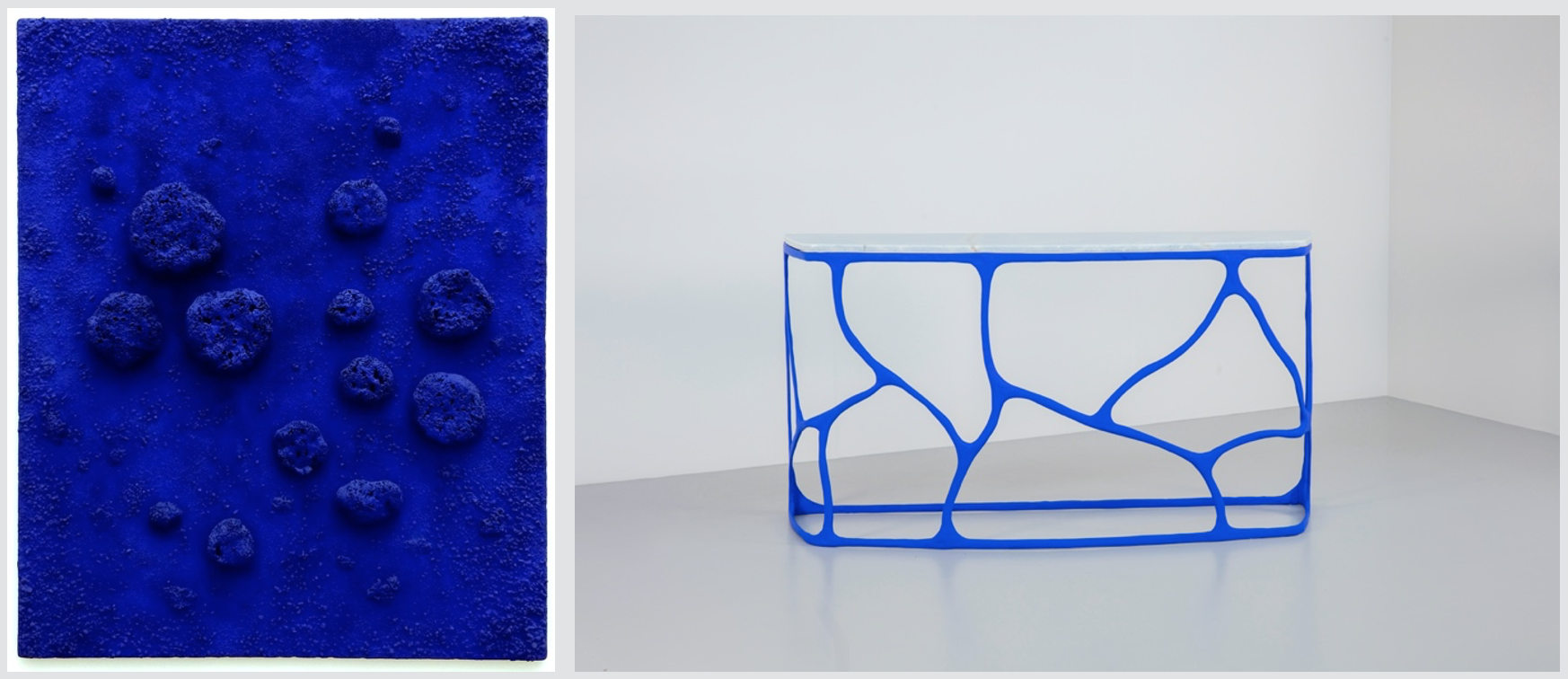
Left: Yves Klein’s L’accord bleu (1960); Right: Tom Faulkner’s Boulder Console Table in Yves Klein Blue with Azure Ciel marble
Yves Klein Blue
So much of Yves Klein’s oeuvre revolves around the colour blue that he’s earned an eponymous shade. His electrifying hue graces sculptures and canvases, delivering an energising jolt of vivaciousness. Something as simple as sponges on a canvas, á-la L’accord bleu (1960), comes alive with a wash of Yves Klein blue. The usual resigned quietude of the colour is supplanted by a distinct vigour. Tom Faulkner takes this as inspiration, zapping the sinuous lines of his classic Boulder Console Table with an Yves Klein blue that transmutes them into tendrils of electricity. It’s a colour that one can’t help but notice in a room, indelibly changing the energy of the space.
The power of blue takes many forms. It can invigorate viewers with an electric buzz of energy. It can conjure and impart a sense of aloof melancholia, or even emotional anguish. Artists may harness it in adulation of their subjects, or even use it to create space for the emergence of hope and possibility. It’s a strange and slippery conduit that flows across the arts, carrying with it strong emotional undercurrents. It can drag us deep or send us gliding to promising new shores. Its emotive tides wash over us with a ubiquitous force that, while awesome, bears keeping one eye on the shore.
Text by Annabel Colterjohn
